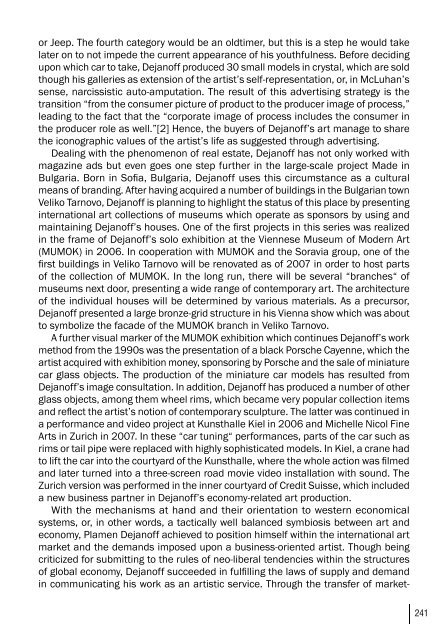art-e-conomy _ reader - marko stamenkovic
art-e-conomy _ reader - marko stamenkovic
art-e-conomy _ reader - marko stamenkovic
Create successful ePaper yourself
Turn your PDF publications into a flip-book with our unique Google optimized e-Paper software.
or Jeep. The fourth category would be an oldtimer, but this is a step he would take<br />
later on to not impede the current appearance of his youthfulness. Before deciding<br />
upon which car to take, Dejanoff produced 30 small models in crystal, which are sold<br />
though his galleries as extension of the <strong>art</strong>ist’s self-representation, or, in McLuhan’s<br />
sense, narcissistic auto-amputation. The result of this advertising strategy is the<br />
transition “from the consumer picture of product to the producer image of process,”<br />
leading to the fact that the “corporate image of process includes the consumer in<br />
the producer role as well.”[2] Hence, the buyers of Dejanoff’s <strong>art</strong> manage to share<br />
the iconographic values of the <strong>art</strong>ist’s life as suggested through advertising.<br />
Dealing with the phenomenon of real estate, Dejanoff has not only worked with<br />
magazine ads but even goes one step further in the large-scale project Made in<br />
Bulgaria. Born in Sofia, Bulgaria, Dejanoff uses this circumstance as a cultural<br />
means of branding. After having acquired a number of buildings in the Bulgarian town<br />
Veliko Tarnovo, Dejanoff is planning to highlight the status of this place by presenting<br />
international <strong>art</strong> collections of museums which operate as sponsors by using and<br />
maintaining Dejanoff’s houses. One of the first projects in this series was realized<br />
in the frame of Dejanoff’s solo exhibition at the Viennese Museum of Modern Art<br />
(MUMOK) in 2006. In cooperation with MUMOK and the Soravia group, one of the<br />
first buildings in Veliko Tarnovo will be renovated as of 2007 in order to host p<strong>art</strong>s<br />
of the collection of MUMOK. In the long run, there will be several “branches“ of<br />
museums next door, presenting a wide range of contemporary <strong>art</strong>. The architecture<br />
of the individual houses will be determined by various materials. As a precursor,<br />
Dejanoff presented a large bronze-grid structure in his Vienna show which was about<br />
to symbolize the facade of the MUMOK branch in Veliko Tarnovo.<br />
A further visual marker of the MUMOK exhibition which continues Dejanoff’s work<br />
method from the 1990s was the presentation of a black Porsche Cayenne, which the<br />
<strong>art</strong>ist acquired with exhibition money, sponsoring by Porsche and the sale of miniature<br />
car glass objects. The production of the miniature car models has resulted from<br />
Dejanoff’s image consultation. In addition, Dejanoff has produced a number of other<br />
glass objects, among them wheel rims, which became very popular collection items<br />
and reflect the <strong>art</strong>ist’s notion of contemporary sculpture. The latter was continued in<br />
a performance and video project at Kunsthalle Kiel in 2006 and Michelle Nicol Fine<br />
Arts in Zurich in 2007. In these “car tuning“ performances, p<strong>art</strong>s of the car such as<br />
rims or tail pipe were replaced with highly sophisticated models. In Kiel, a crane had<br />
to lift the car into the courtyard of the Kunsthalle, where the whole action was filmed<br />
and later turned into a three-screen road movie video installation with sound. The<br />
Zurich version was performed in the inner courtyard of Credit Suisse, which included<br />
a new business p<strong>art</strong>ner in Dejanoff’s e<strong>conomy</strong>-related <strong>art</strong> production.<br />
With the mechanisms at hand and their orientation to western economical<br />
systems, or, in other words, a tactically well balanced symbiosis between <strong>art</strong> and<br />
e<strong>conomy</strong>, Plamen Dejanoff achieved to position himself within the international <strong>art</strong><br />
market and the demands imposed upon a business-oriented <strong>art</strong>ist. Though being<br />
criticized for submitting to the rules of neo-liberal tendencies within the structures<br />
of global e<strong>conomy</strong>, Dejanoff succeeded in fulfilling the laws of supply and demand<br />
in communicating his work as an <strong>art</strong>istic service. Through the transfer of market-<br />
241


